Last week, the market made up for its holiday-shortened schedule with an impressive display of several bearish mirages, one-by-one, fading into the next bullish oasis that further fueled the bulls’ confidence.
The Two July Highs
Last week also established a bullish pattern at the start of what is typically one of the most bullish months of the year. July is also a pivotal month for determining market reversals that often frighten investors in the late summer and early fall. This tendency for July to identify the high is particularly pronounced after significant rallies, such as the one we’re experiencing.
The first July high isn’t a price point; it’s investor enthusiasm. There were several demonstrations of this last week, but the market’s strongest such message came on Friday when the nonfarm reported numbers that were “status quo.”
There is a growing feeling that the labor market is weakening. This feeling is shared by Fed Chair Powell, and therefore, viewed as a potential lever that could push the Fed to .
Leading up to the report, vocal investors seemed increasingly certain that they saw Thursday about to provide hard data indicating a long-awaited acceleration of significant weakening in the labor market.
In fact, consensus estimates for growth in payrolls ranged from 106k-110k, but the Street’s whisper number was believed to be as low as 95k.
As a result, the reported number of 147k jobs added was substantially higher than the mirage of weakness that preceded the report. Furthermore, the , which was previously 4.2% and expected to rise to 4.3%, instead fell to 4.1%.
Finally, the other component of the bears’ mirage of trouble in the current labor market is wage inflation. That mirage also evaporated when the expectations for average hourly earnings to rise from 0.3% to 0.4% reported a decline to 0.2%.
While the media will pick apart the reams of data in the report to find all kinds of reasons the “market got it wrong,” the big picture is that the key metrics continued the “status quo” slowly weakening trends in the labor market, but investors were expecting worse, and that’s bullish.
Furthermore, there is a loud desire for the Fed to cut rates, but Thursday’s market action demonstrated that it is certainly not a requirement for this market to move higher. In fact, fed funds markets’ expectations for a rate cut in July dropped from about 23% to about 4%, and the odds of a cut in September’s meeting fell from about 90% to 73%.
Considering the seasonally strong performance of July shown below, and several other bearish mirages that are in the process of following the same bullish path as Thursday’s labor report, the summer is likely to heat up!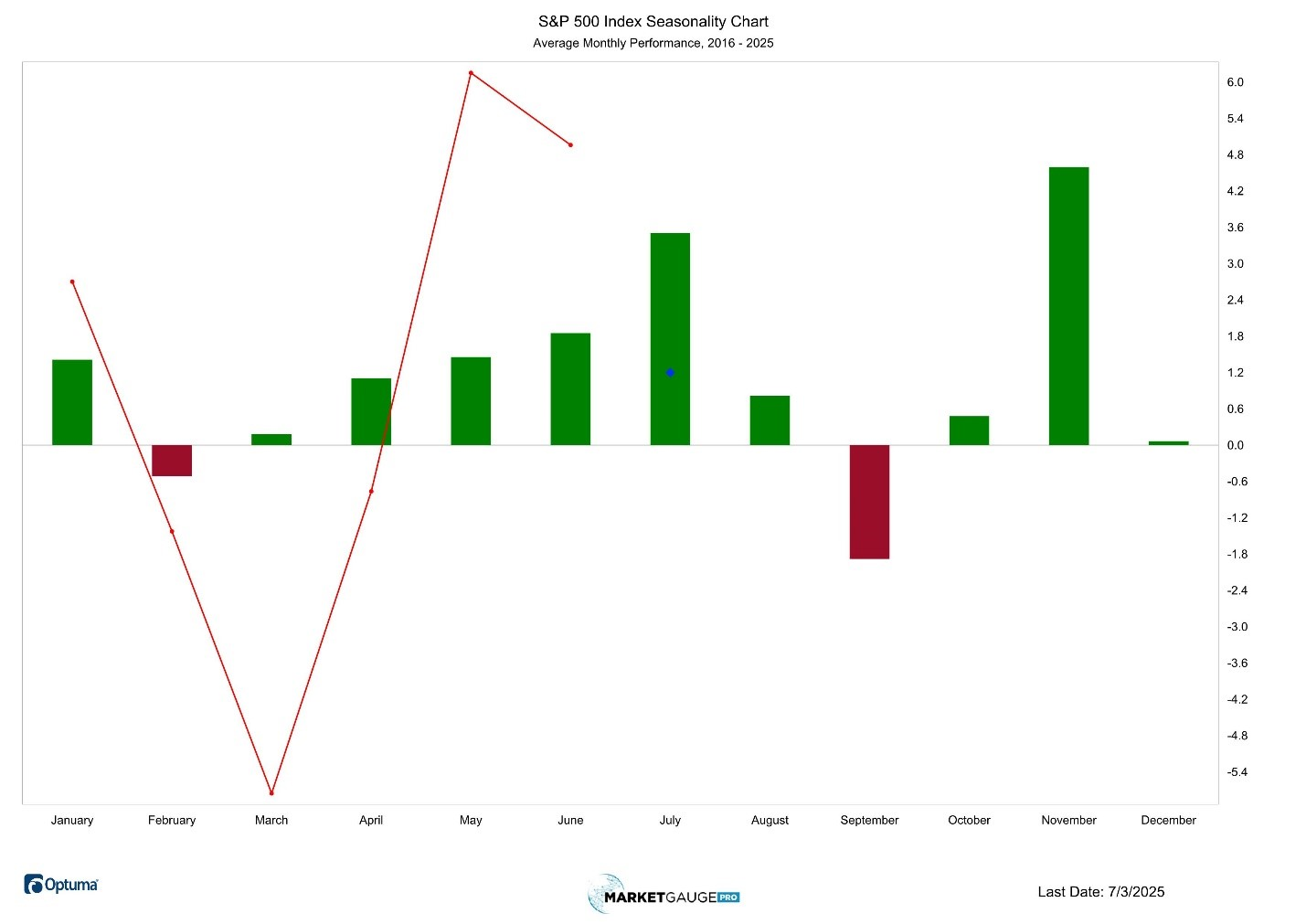
Are Expectations of Rising Unemployment Rate Another Bearish Mirage
Chair Powell has pointed to the as a key metric for measuring the strength of the labor market and an important factor in determining monetary policy. He’s also suggested that the trends in immigration are likely to have a material impact on the unemployment rate.
In a January 2025 news conference, he remarked, “The flows across the border have decreased very significantly, and there’s every reason to expect that to continue. But job creation has come down a bit, too. So if those two things come down together, that can be a reason for the unemployment rate to stabilize.” wsj.com
Simply put, less immigration may put downward pressure on the unemployment rate and create a counterintuitive situation where new job creation data declines and the unemployment rate remains low.
The chart below shows the existence of this relationship over the last year. Since July 2024, the 6-month average of change in nonfarm payrolls has dropped from about 225k to about 160k last month (blue line). During this time, border encounters have declined from 90k to under 10k.
During the same time, the unemployment rate has been locked in a very tight range of 4.0% to 4.2%.
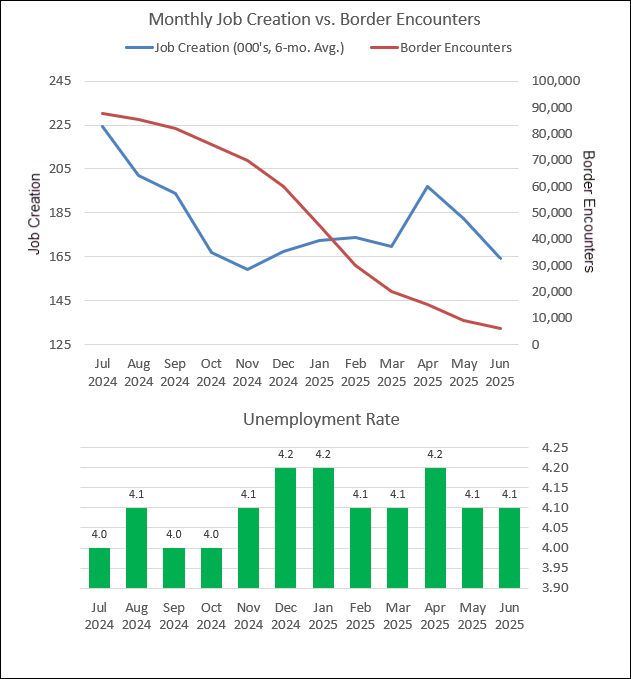
In case the implications for monetary policy are not obvious…
The administration is determined to dramatically reduce the number of immigrants in the U.S., which may prolong the time it takes for the unemployment rate to rise to a level that concerns equity bulls and the Fed feels justifies cutting rates.
The Bearish Tariff Mirage
The 90-day tariff pause is only days away, and the market’s reaction to most tariff announcements appears to be positive. The market doesn’t appear to believe the extraordinary threats that led to the pause will materialize, and therefore, the certainty that can be gained by a tariff agreement has been bullish. For example, Wednesday’s announcement of an agreement on a 20% tariff rate with Vietnam resulted in positive action in stocks and in some cases, like Nike (NYSE:), the bullish moves were substantial.
It may be a good bet to expect the days following July 9th to be bullish as fear of the effects of tariffs rapidly declines.
Tariff Inflation?
Even if the tariffs don’t create a substantial slowing in the economy, there is still a concern that they will lead to inflation. Chair Powell, for example, is expecting to shape monetary policy around measurable impacts of tariff inflation.
However, there hasn’t been any substantial evidence of this in the macro data points. It may be too early to expect it in the macro data, but the upcoming earnings season should provide some insight into where the costs of the tariffs are being absorbed or passed on to.
This will potentially make the second “July High” a very timely indicator. The second July High is the July Calendar Range.
The July Calendar Range
After a substantial move up or down in the market, the July Calendar Range serves as the range that can identify trend changes in the same way that a break in the January Calendar Range identifies a new trend.
If you’re not familiar with MarketGauge’s Calendar Range tactics, I’d recommend that you contact Rob Quinn for a demo conversation on how you can learn how it can help you be on the right side any market’s trend – index, stock, ETF, etc.
For example, the chart below shows the with the July Calendar Range High and Low shown with blue and magenta lines, respectively.
As you can see from the annotations, learning how to identify range breakouts and reversals allows you to clearly determine when to be bullish and bearish.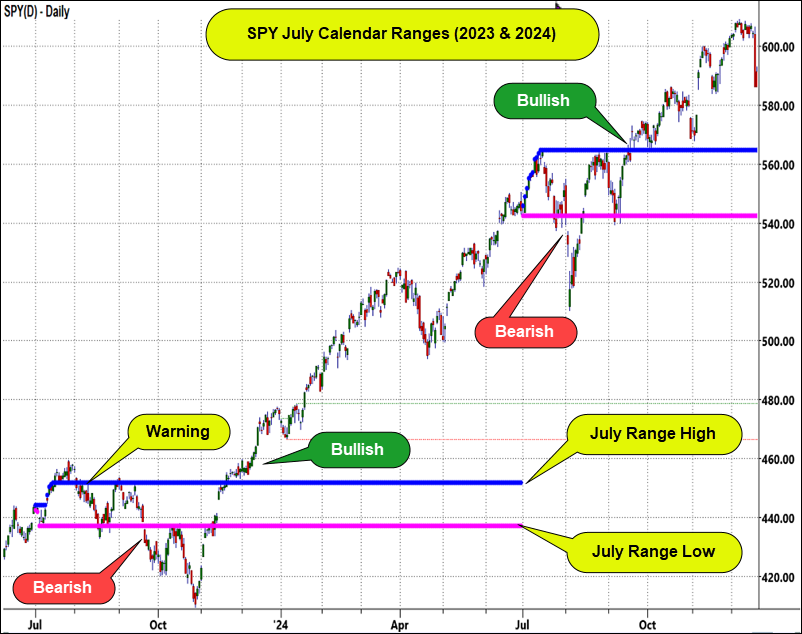
The simple application of the range in 2025 will be to wait for it to form, and then, within a couple of weeks, earnings season will begin to weigh on or lift the market. The range will tell you if the movement is strong enough to expect the trend to continue or reverse.
Beware of Animal Spirits
The first half of the year was filled with bearish challenges or mirages like a tariff-induced recession, tariff-fueled inflation, budget legislation that would balloon the deficit and spike interest rates, war in the Middle East, a weakening labor market, and more.
As we enter the second half of the year, investors appear to have been able to digest, look past and even use all of the bearishness to fuel a bull that climbs a wall of worry.
In fact, according to the AAII sentiment data shown below, the spread between the % of Bulls vs Bears has not been this bullish since January 2025.
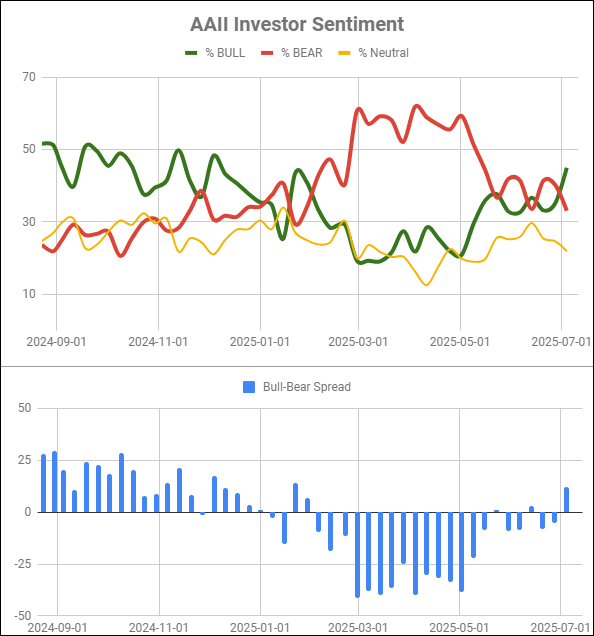
Last week’s market action was also indicative of a renewed and emboldened bull market. As you can see from the chart below, the market broadened out as demonstrated by IWM outperforming and , and the equal weight ETFs of and outperformed their respective cap. weighted ETFs, SPY and QQQ.
Furthermore, the rotation into underperforming areas isn’t coming at the expense of the market leaders.
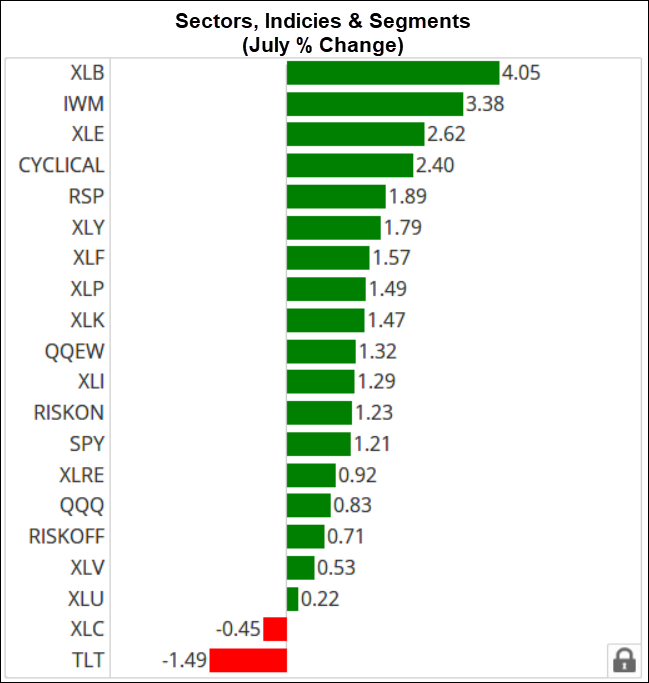
With the July Range or some other good risk management tactics, it looks like the risk for the active investors isn’t in Bearish mirages, but rather in missing the upside should animal spirits continue to gain momentum.
If you don’t have a methodical approach to the market (algorithmic or discretionary), now’s the time to double down on discipline and risk management and let the upside take care of the rest.
Summary: Markets are firmly in risk-on mode, with bullish price action across sectors, strengthening internals, surging growth leadership, and volume signaling broad accumulation. Although and interest rates remain in consolidation, the market shows strong seasonal momentum and breadth, supported by low volatility and 100% positive risk gauges.
Risk On
- Price action in the markets is risk-on. Our Real Motion in QQQ & SPY is not overbought, indicating more potential upside. Small Caps, a concern last week, has resolved to the upside. S&P 500 also crossed into a bullish phase. (+)
- Volume saw a big shift from the prior week, favoring accumulation days in all the indexes except . (+)
- Positive price action across all sectors with homebuilders and retail significantly improving and semiconductors hitting a new all-time high. (+)
- Solar, which had been lagging the market, surged this week, regaining all it’s underperformance over the last six months. (+)
- Market internals strengthened significantly, running strong, but not overbought and the cumulative Advance-Decline made a new 52-week high. (+)
- New High New Low Ratio improved to bullish across the board. (+)
- Color Charts (moving average of stocks above key moving averages) showing 100% bullish readings across all indexes and time frames. (+)
- Risk gauges strengthened to 100% positive with all relationships showing risk-on. (+)
- Volatility continued to pull off reaching its lowest levels since February. (+)
- Growth continues to lead and hit new all-time highs and we had strong performance and close to taking out the all-time highs in value. Everything looks in gear with growth leading. (+)
- The modern family showed great improvement in five of the six family members on great volume, although we are starting to run a bit rich in Grandpa . (+)
- Emerging and developed markets fell off a bit in relative performance to the U.S., but both still strong in bull phases. (+)
- Aggs are lagging the S&P in a distribution phase, signalling easing inflationary pressures. (+)
- remains strong. It got a little overbought on real motion, potentially digesting the recent move. (+)
- broke above a significant trendline from the May-June highs and if it can hold around current levels, projects higher prices. (+)
- July is one of the strongest seasonal periods for markets in the last ten years and is off to a hot start to the month. (+)
Neutral
- Gold continues to consolidate near it’s all-time highs and in a bullish phase. It is losing momentum. (=)
- Rates are in a consolidation rage with an unclear reading for any potential July action from the Fed. (=)
